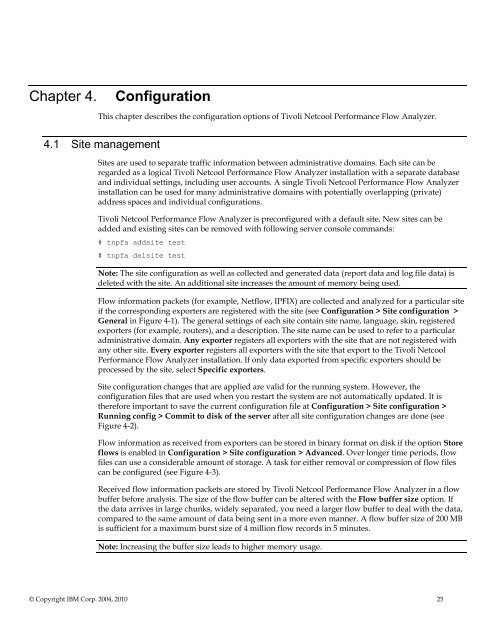TNPFA 4.1.1 Installation and User Guide - e IBM Tivoli Composite ...
TNPFA 4.1.1 Installation and User Guide - e IBM Tivoli Composite ...
TNPFA 4.1.1 Installation and User Guide - e IBM Tivoli Composite ...
Create successful ePaper yourself
Turn your PDF publications into a flip-book with our unique Google optimized e-Paper software.
Chapter 4. Configuration<br />
This chapter describes the configuration options of <strong>Tivoli</strong> Netcool Performance Flow Analyzer.<br />
4.1 Site management<br />
Sites are used to separate traffic information between administrative domains. Each site can be<br />
regarded as a logical <strong>Tivoli</strong> Netcool Performance Flow Analyzer installation with a separate database<br />
<strong>and</strong> individual settings, including user accounts. A single <strong>Tivoli</strong> Netcool Performance Flow Analyzer<br />
installation can be used for many administrative domains with potentially overlapping (private)<br />
address spaces <strong>and</strong> individual configurations.<br />
<strong>Tivoli</strong> Netcool Performance Flow Analyzer is preconfigured with a default site. New sites can be<br />
added <strong>and</strong> existing sites can be removed with following server console comm<strong>and</strong>s:<br />
# tnpfa addsite test<br />
# tnpfa delsite test<br />
Note: The site configuration as well as collected <strong>and</strong> generated data (report data <strong>and</strong> log file data) is<br />
deleted with the site. An additional site increases the amount of memory being used.<br />
Flow information packets (for example, Netflow, IPFIX) are collected <strong>and</strong> analyzed for a particular site<br />
if the corresponding exporters are registered with the site (see Configuration > Site configuration ><br />
General in Figure 4-1). The general settings of each site contain site name, language, skin, registered<br />
exporters (for example, routers), <strong>and</strong> a description. The site name can be used to refer to a particular<br />
administrative domain. Any exporter registers all exporters with the site that are not registered with<br />
any other site. Every exporter registers all exporters with the site that export to the <strong>Tivoli</strong> Netcool<br />
Performance Flow Analyzer installation. If only data exported from specific exporters should be<br />
processed by the site, select Specific exporters.<br />
Site configuration changes that are applied are valid for the running system. However, the<br />
configuration files that are used when you restart the system are not automatically updated. It is<br />
therefore important to save the current configuration file at Configuration > Site configuration ><br />
Running config > Commit to disk of the server after all site configuration changes are done (see<br />
Figure 4-2).<br />
Flow information as received from exporters can be stored in binary format on disk if the option Store<br />
flows is enabled in Configuration > Site configuration > Advanced. Over longer time periods, flow<br />
files can use a considerable amount of storage. A task for either removal or compression of flow files<br />
can be configured (see Figure 4-3).<br />
Received flow information packets are stored by <strong>Tivoli</strong> Netcool Performance Flow Analyzer in a flow<br />
buffer before analysis. The size of the flow buffer can be altered with the Flow buffer size option. If<br />
the data arrives in large chunks, widely separated, you need a larger flow buffer to deal with the data,<br />
compared to the same amount of data being sent in a more even manner. A flow buffer size of 200 MB<br />
is sufficient for a maximum burst size of 4 million flow records in 5 minutes.<br />
Note: Increasing the buffer size leads to higher memory usage.<br />
© Copyright <strong>IBM</strong> Corp. 2004, 2010 25

















